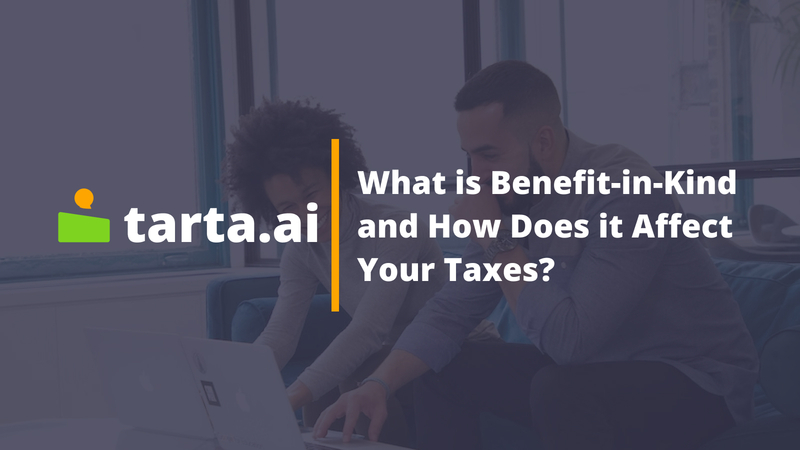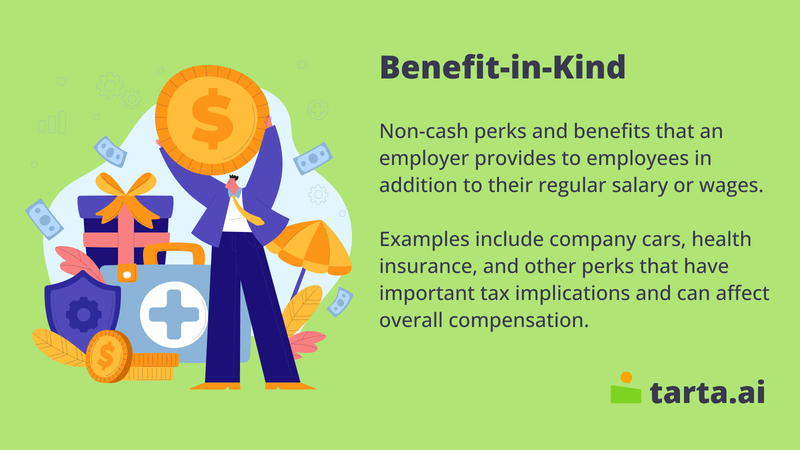What is Benefit-in-Kind and How Does it Affect Your Taxes?

The term "Benefit-in-Kind" refers to any non-cash benefit that an employee receives from their employer in addition to their salary. This can include items such as company cars, health insurance, housing, or even free meals at work.
While these benefits can be a great perk for employees, they also have important tax implications that both employers and employees should be aware of. In this article, we'll explore what Benefit-in-Kind is and how it can affect your taxes.
Understanding Benefit-in-Kind is crucial for tax planning purposes. If you don't properly account for these benefits on your tax return, you may end up owing more taxes than you anticipated. On the other hand, if you're an employer who offers Benefit-in-Kind to your employees, you need to ensure that you're correctly reporting these benefits to the government and complying with relevant tax laws.
With that in mind, let's take a closer look at Benefit-in-Kind and its tax implications.
What is Benefit-in-Kind?
Benefit-in-Kind refers to any non-cash benefit that an employee receives from their employer in addition to their salary. These benefits are considered a form of compensation and are subject to tax.
The value of Benefit-in-Kind is calculated based on the cost to the employer, not the actual value to the employee. For example, if an employer provides a company car to an employee, the value of the Benefit-in-Kind is not based on how much the employee values the car, but rather on how much the employer spent to purchase and maintain the car.

Examples of Benefit-in-Kind can include:
- Company cars
- Health insurance
- Housing or accommodation
- Gym memberships
- Childcare services
- Free or subsidized meals at work
- Mobile phones or other electronic devices
- Travel expenses, such as flights or train tickets
Some benefits may be exempt from tax, depending on the specific circumstances. For example, if an employer provides a bicycle to an employee for commuting purposes, this Benefit-in-Kind may be exempt from tax. However, the rules around tax exemptions for Benefit-in-Kind can be complex and will vary depending on the country and the specific benefit in question.
How Benefit-in-Kind Affects Your Taxes
Benefit-in-Kind can have a significant impact on your tax liability. In general, the value of the Benefit-in-Kind is added to your taxable income, which can increase the amount of tax you owe. However, the specific tax implications will depend on the nature of the Benefit-in-Kind and the tax laws in your country.
Let's take a closer look at some specific examples of Benefit-in-Kind and how they can affect your taxes:
- Taxation of company cars
If an employer provides a company car to an employee, the value of the Benefit-in-Kind is calculated based on the list price of the car, its CO2 emissions, and other factors. This value is then added to the employee's taxable income, which can increase the amount of tax they owe. However, there are some tax exemptions and reductions available for low-emission or electric cars, so it's worth checking the specific rules in your country.
- Taxation of health insurance
In some countries, employer-provided health insurance is considered a Benefit-in-Kind and is subject to tax. The value of the Benefit-in-Kind is typically calculated based on the cost of the insurance policy, which is then added to the employee's taxable income. However, there may be exemptions or reductions available for certain types of insurance policies.
Fact:
According to a survey by the Society for Human Resource Management, in 2020, 89% of organizations in the US offered healthcare benefits to their employees.
- Taxation of other benefits
The tax implications of other types of Benefit-in-Kind will depend on the specific benefit and the rules in your country. For example, if an employer provides free meals to employees, the value of this Benefit-in-Kind may be subject to tax. Similarly, if an employer provides housing or accommodation, the value of this Benefit-in-Kind may be added to the employee's taxable income.
It's important to note that the rules around Benefit-in-Kind taxation can be complex, and it's often best to seek advice from a tax professional to ensure that you're correctly reporting these benefits on your tax return. Failing to properly account for Benefit-in-Kind on your tax return can result in penalties or other legal consequences.
Advantages of Benefit-in-Kind
While Benefit-in-Kind can have tax implications, there are also a number of advantages for both employers and employees.
- Advantages for employers
Offering Benefit-in-Kind can be a way for employers to attract and retain employees. By providing non-cash benefits in addition to salary, employers can create a more attractive compensation package for their employees. This can help to increase job satisfaction, reduce turnover, and improve overall productivity.
Additionally, some types of Benefit-in-Kind may be tax-deductible for employers, which can help to offset the cost of providing these benefits. For example, in some countries, employers may be able to claim a tax deduction for the cost of providing health insurance to employees.
- Advantages for employees
For employees, Benefit-in-Kind can be a valuable perk that can help to improve their quality of life. For example, employer-provided health insurance can help to reduce out-of-pocket healthcare costs, while a company car can provide convenience and flexibility for commuting or business travel.
Additionally, some types of Benefit-in-Kind may be exempt from tax or subject to reduced tax rates. For example, employer-provided childcare services may be exempt from tax, which can help to reduce the financial burden of childcare for working parents.
Fact:
In 2020, the IRS announced that the maximum value of employer-provided tax-free transportation benefits was $270 per month for parking and $270 per month for transit passes and vanpooling.
Overall, Benefit-in-Kind can be a win-win for both employers and employees, providing valuable benefits that can help to improve job satisfaction, productivity, and overall quality of life.
Drawbacks of Benefit-in-Kind
While Benefit-in-Kind can have advantages for both employers and employees, there are also some potential drawbacks to consider.
- Disadvantages for employers
Providing Benefit-in-Kind can be costly for employers, both in terms of the direct cost of providing these benefits and the administrative burden of managing them. Additionally, the tax implications of Benefit-in-Kind can be complex, and failing to properly account for these benefits on tax returns can result in penalties or other legal consequences.
Additionally, offering certain types of Benefit-in-Kind, such as company cars or housing, can create a sense of entitlement among employees. This can make it difficult for employers to adjust or remove these benefits if necessary, which can lead to resentment or decreased morale.
- Disadvantages for employees
While Benefit-in-Kind can be a valuable perk, it's important to remember that these benefits are considered a form of compensation and are subject to tax. This means that employees may end up paying more in taxes as a result of receiving these benefits, which can reduce their overall take-home pay.
Additionally, some types of Benefit-in-Kind may not be relevant or useful for all employees. For example, if an employer provides a company car, this may not be a valuable benefit for employees who live within walking distance of the office or who primarily work remotely.
Finally, some types of Benefit-in-Kind may be subject to restrictions or limitations that can make them less useful for employees. For example, an employer-provided gym membership may only be valid at certain locations or during certain hours, which may not be convenient for all employees.
Overall, while Benefit-in-Kind can be a valuable perk, it's important for both employers and employees to carefully consider the potential drawbacks and ensure that these benefits align with their needs and priorities.
Managing Benefit-in-Kind
Effectively managing Benefit-in-Kind can help both employers and employees get the most out of these benefits.
To manage Benefit-in-Kind effectively, employers should:
- Clearly communicate the details of Benefit-in-Kind to employees, including any tax implications, limitations, or restrictions.
- Regularly review and evaluate the cost and effectiveness of providing Benefit-in-Kind to ensure that these benefits align with the company's overall goals and priorities.
- Ensure that Benefit-in-Kind is administered fairly and consistently across all employees, to avoid claims of discrimination or favoritism.
- Maintain accurate records of all Benefit-in-Kind provided to employees, including the value and tax treatment of each benefit.
- Work with tax and legal professionals to ensure compliance with all relevant regulations and reporting requirements.
To make the most of Benefit-in-Kind, employees should:
- Take advantage of all relevant benefits provided by their employer, and familiarize themselves with the tax treatment and value of each benefit.
- Consider the potential tax implications of Benefit-in-Kind when evaluating the overall value of their compensation package.
- Communicate with their employer if they have questions or concerns about Benefit-in-Kind, and advocate for benefits that align with their individual needs and priorities.
- Keep accurate records of any Benefit-in-Kind received, including the value and tax treatment of each benefit, to ensure compliance with tax regulations and reporting requirements.
- Regularly review their compensation package and consider whether changes to their Benefit-in-Kind would better align with their needs and priorities.
By following these best practices and tips, both employers and employees can effectively manage Benefit-in-Kind and maximize the benefits these perks provide.
Fact:
The Tax Cuts and Jobs Act of 2017 made several changes to the tax treatment of Benefit-in-Kind, including eliminating the tax deduction for employee entertainment expenses and capping the tax deduction for business meals.
In conclusion, Benefit-in-Kind refers to non-cash perks and benefits that an employer provides to employees in addition to their regular salary or wages. While these benefits can be valuable and help to attract and retain talent, they also have important tax implications that must be carefully considered by both employers and employees.
Employers must ensure that they understand the tax treatment of Benefit-in-Kind and properly account for these benefits on tax returns to avoid penalties or legal consequences. Additionally, employers must carefully evaluate the costs and benefits of providing these perks to ensure that they align with the company's overall goals and priorities.
Employees, in turn, must understand the tax implications of Benefit-in-Kind and consider these benefits when evaluating their overall compensation package. By carefully managing Benefit-in-Kind, both employers and employees can ensure that they are getting the most value out of these perks while also complying with all relevant tax and legal regulations.
Overall, understanding Benefit-in-Kind is an important part of tax planning for both employers and employees. By working together to manage these benefits effectively, employers can attract and retain top talent while employees can maximize the value of their compensation package.
FAQ
What is Benefit-in-Kind?
Benefit-in-Kind refers to non-cash perks and benefits provided by employers to employees in addition to their regular salary or wages.
Examples of Benefit-in-Kind include company cars, health insurance, gym memberships, housing allowances, and other non-cash benefits that employers provide to employees.
How does Benefit-in-Kind affect taxes?
Benefit-in-Kind has important tax implications for both employers and employees. Employers must report the fair market value of Benefit-in-Kind provided to employees on their tax returns, and employees may be subject to additional taxes on the value of the benefits they receive.
What are the advantages and drawbacks of Benefit-in-Kind?
Advantages of Benefit-in-Kind include attracting and retaining top talent, improving employee satisfaction and productivity, and providing employees with valuable perks and benefits that can enhance their overall compensation.
Drawbacks of Benefit-in-Kind include additional administrative and reporting requirements for employers, potential tax implications for employees, and the risk of providing benefits that may not be valued by all employees.
How can Benefit-in-Kind be managed effectively?
Managing Benefit-in-Kind effectively requires clear communication, accurate record-keeping, and compliance with all relevant regulations. Employers should also consider offering a variety of benefits to meet the diverse needs of their employees.